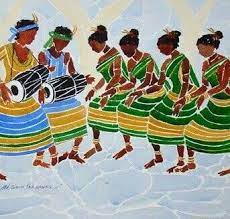Culture Of Jharkhand
They practice Sarnaism, Christianity and Hinduism religion. They have many folk dances, music and art. They celebrate festivals like Mage Parab, Sorhai, Baha parab, Karam, Sarhul and Phagu. Santhals is one of the largest communities in Jharkhand.

Hindi is official language of Jharkhand. There are many regional and tribal languages in Jharkhand. The regional languages that belong to the Indo-Aryan branch; in Jharkhand, they are Khortha, Nagpuri, and Kudmali spoken by the Sadan. Other Indo-Aryan languages include Bhojpuri, Magahi, Maithili, Bengali, and Odia. The languages that belong to the Austroasiatic branch are Mundari, Santali, and Ho. The languages that belong to the Dravidian language family are Kurukh and Malto. The staple foods in Jharkhand are rice, dal, vegetables, and tubers. Some dishes include Chilka roti, Pilts Malpua, Dhuska, Arsa roti, and Litti Chokha. Rugra (a type of mushroom) and bamboo shoots are also used as vegetables The leaves of the Munga tree (Moringa oleifera) and the Koinar tree (Bauhinia variegata) are used as leafy vegetables or Saag. Local alcoholic drinks are Handia made from rice and Mahua daru made from flowers of the Mahua tree. Karam is a major native harvest festival of Jharkhand. It is celebrated on the 11th day of a full moon of the month of Bhado by the Sadan (Khortha, Nagpuri, Kurmali-speaking ethnic group) and the tribal (Munda, Bhumij, Santal and Kurukh) people of Jharkhand. During this festival, people bring branches of the Karam tree to the village and then place them on the ground. The branches are washed with milk and handia, and decorated with garlands, curd, rice, flowers and grains. The village priest "Pahan" offer sacrifice of Karm devta for good harvest. Jharkhand produces many films in regional languages, including Nagpuri, Khortha, Santali, Ho, and Kurukh.The first feature film of Jharkhand was Aakarant, made under the banner of Drishyantar International in 1988. The first Nagpuri film was Sona Kar Nagpur (1994), produced and directed by Dhananjay Nath Tiwari.